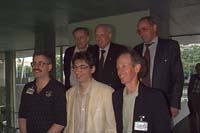DAILY BULLETIN Chief Editor: H. Francis • Editors: M. Horton-B. Senior • Web Editor: Th. Matziaris No.: 2 • Saturday, 22 August 1998 |
| Results | Contents |
| Rosenberg Wins Par Contest |

The winners are all smiles after being awarded their prizes in the Par Contest. Front, left to right: Eric Rodwell, third place; Michael Rosenberg, the winner, and Bart Bramley, runner-up. Back: Pietro Bernasconi, author of the problems; Jaime Ortiz-Patino, president of the Jean Besse Foundation, and José Damiani, WBF president. Michael Rosenberg (USA) won the Par Contest, overtaking the leader, Cesary Balicki of Poland in the final session and holding off a strong challenge from fellow Americans Bart Bramley and Eric Rodwell. The Jean Besse Trophy was presented to Rosenberg by WBF President, José Damiani, along with the first prize of $35,000, at an awards ceremony attended by all the participants. Besse's widow Rachel was also present at the ceremony. Awards were made to the top ten finishers by Damiani, Jaime Ortiz-Patino and Pietro Bernasconi. The other major prizes were $17,500 to second (Bramley), $10,000 to third (Rodwell) and $6,500 to fourth (Balicki). The prize fund of 100,000 Swiss francs was provided by the Jean Besse Foundation, which is chaired by Ortiz-Patino. This was only the second par contest of the modern era. Ely Culbertson organised the first such event as long ago as 1932. Thereafter, the event was staged every year by the USA until 1941 when it was abandoned. Australian experts Michael Sullivan and Robert Williams revived the contest in 1961, but the last time it was held using traditional methods was in 1963. The advent of the personal computer made it possible to use a new improved format, inaugurated at the 1990 World Championships in Geneva and won by Benito Garozzo. Each player sits at a personal computer terminal, provided by Compaq Computers. This allows for ideal conditions, with no outside disturbance or influence of any kind and without the need for live opponents or tournament directors. The computer displays the details of the problem. As the players type in their plays, the computer makes the defensive plays, tells the contestants when they have made an error, keeps a record of the time taken, and keeps the competitors' score. The 34-strong field (plus Matt Ginsberg's GIB computer program) played 12 tough deals set by Swiss maestro, Pietro Bernasconi. In a Par Contest, declarer has to play in the theoretically correct manner - he cannot make a lucky guess to land his contract just because the cards happen to lie favourably for his chosen line. The competitors were allowed three 'lives' on each problem. They started each problem with 2000 points in the bank and each incorrect play cost them points. The third wrong play on any problem meant zero points would be scored on it. Also, the competitors were charged points for the amount of time they took to solve the problem. So the points listed in the final ranking table are what the competitors were left with after paying for their time and errors. A perfect score would have been 6000 per session and 24000 in all - assuming all correct answers in zero time. Rosenberg was, of course, delighted to have won the competition, but commented that he understood Bramley to have made one less error than himself over the 12 deals so that he had only won because he solved the problems more quickly than the runner-up. Rosenberg felt it was wrong that the competition should be decided on time. Matt Ginsberg's Goren In a Box program performed very well and was actually leading the event at the halfway point. It struggled a little in the third and fourth sessions, largely due to having problems using inferences available from the bidding given. Nonetheless, Ginsberg was delighted that GIB had performed better than he had expected. He was so sufficiently confident that he was heard asking Zia after the competition, how long he thought it would be before GIB would be the best player in the world. It seems that the main improvement required for this to be achieved is in the bidding data base; its declarer play technique is already top class. The Par Contest has been named the Jean Besse Trophy Par Contest to commemorate one of the best minds the game has known. "And the link between the man and the contest is strong," says Jaime Ortiz-Patino, president emeritus of the World Bridge Federation. "The word 'algorithm' is now an accepted part of computer technology. But long before the computer age Jean was recognised as having an unusually algorithmic cast of mind." Patino further stated that Besse solved bridge problems by means of an orderly sequence of logical steps, making less use of intuition, as distinct from table presence, than any of his peers. However, Besse also was an expert at interpreting table presence as well, according to Patino. WBF President José Damiani said the WBF is particularly pleased to have organised this contest once again, with the cooperation of the Jean Besse Foundation and Pietro Bernasconi. "The generosity of Mrs. Rachel Besse has been met with great enthusiasm by the champions, apparently unfazed by the difficulty of the hands prepared by Pietro Bernasconi," said Damiani. It is a state of mind that does them credit and that will enable bridge to remain in the forefront of modern technology." |
| Results | Contents |
| To List of Bulletins |